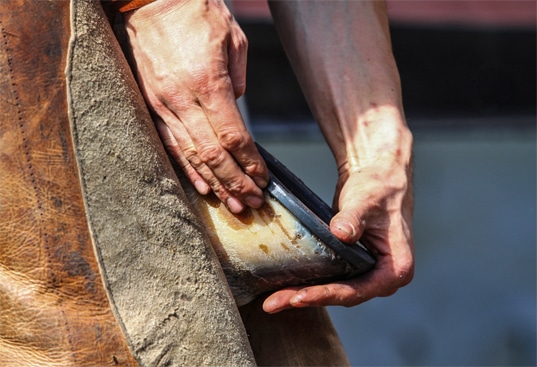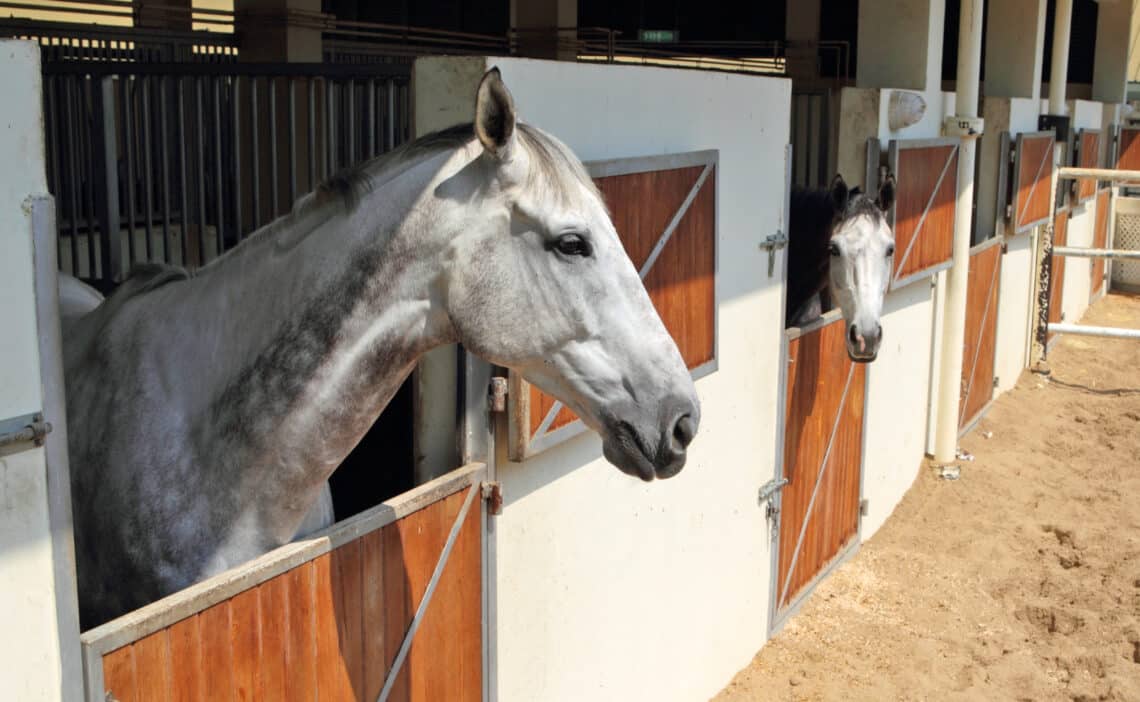A tendon injury diagnosis can feel devastating, but is it the end of your horse’s competition career? RACHEL ROAN spoke to Dr Calum Paltridge.
Tendon injuries typically present with heat and swelling and are painful when touched. X-rays generally don’t reveal tendon damage (unless the tendon has torn off the bone and pulled a piece of bone with it) so an ultrasound or MRI is required. “An ultrasound will show the size and shape of a tendon. An injured tendon will be enlarged,” Dr Calum Paltridge explains. “The tendon fibres are usually aligned longitudinally. An injured tendon will show disruption to the fibres. There may be a big lesion, or hole where the fibres have torn and often that will have filled with fluid.”
Of course, prevention is always better than cure. “While a horse could injure themselves running around in a paddock, you can reduce the risk of injury while working,” Calum continues. “Fitness is the number one thing. If you’re working an unfit horse on a surface they’re not used to, the risk increases.” An exercise regime designed to build your horse up to high level work through gradual strengthening is one way to reduce the risk.

Proactively monitoring for heat or swelling is also wise. Some vets even recommend establishing a baseline for the horse when it’s sound and in work. Correct hoof conformation and farrier work is also essential – an incorrect hoof angle can place unnecessary strain on the tendons. Always seek veterinary advice when you first notice swelling or lameness. Left untreated, tendon damage could increase in severity due to the inflammation process, which can take anywhere from a couple of days to four weeks or more to reduce.
Calum likens tendon injury treatment to that of a human’s sprained ankle or soft tissue injury: rest, ice, and compression. “Stable rest, ice to cool the injury, and compression bandaging will help,” he explains. Wrapping the area in a thick quilted bandage can assist in reducing the swelling, as will twice daily cold water hosing or ice boots in 20-30 minutes sessions.

Medicating with anti-inflammatory drugs such as bute or intramuscular steroids is often a vet’s first approach. “Topical non-steroidal anti-inflammatories rubbed over the injury also support recovery,” Calum adds. The first one to two months can be intensive, as the horse will require stabling and regular ultrasound and lameness examinations to check their progress.
Other available treatments produce varied results. Drugs can be injected into the tendon injury lesion. Platelet rich plasma (PRP), a blood product that provides high levels of growth factors for healing, is effective but can cost several thousand dollars – and, as Calum explains, studies into the ideal PRP treatment regime are still in progress. Shockwave therapy is designed to stimulate tissue regeneration by pulsing very high energy waves through the affected area, and there are some anecdotal reports of success.
Stem cells implanted directly into injured tissue show potential to grow into new tendon cells and stimulate healing – and although a relatively new therapy, there’s evidence to suggest this approach significantly reduces the risk of re-injury when compared to other treatments. In acute cases surgical correction can be used, but this is considered controversial due to its potential to cause further injury.
Many owners use supplements like glucosamine or vitamin C, which might support recovery, but ultimately it comes down to rest and icing. The biggest challenge is often stabling your horse for the necessary period of time, especially if they’re not used to it.
The first few months of recovery are intensive, and keeping your horse in lighter condition helps reduce strain on their injured leg. “It’s important to keep their nutrition up during recovery time, but be careful to monitor their weight. They are no longer able to exercise and added weight can add strain. Slow feeders are useful to prevent boredom when stabled,” Calum suggests.
Gradually, the horse can move from the stable to a small yard, then a paddock, before starting the rehabilitation process into light work. However, recovery time depends on the severity and type of the injury. Generally, tendons need six to twelve months to recover even though after a couple of weeks it’s common for signs of pain and lameness to have disappeared, Calum explains. “Often owners don’t believe the vet, or think the injury wasn’t that bad because the horse appears fine. So they hop back on and begin work too early, only to have the horse re-injure itself.” For mares, putting them in foal is a good way to enforce sufficient rest.
In many cases, the prognosis can be good. “Some horses can return to high level work, but it all depends on the injury, its severity, and whether or not they were rested and rehabilitated correctly,” says Calum. Superficial flexor tendon injuries are most common, followed by bowed tendons. “If they’re given enough time and managed properly, they nearly always come good.”
But Calum also advises riders to be considerate with their training regimes. “A healed tendon will always be a weak spot and the horse will be prone to re-injury. Fitness is very important. You have to bring them back into work properly, slowly building their fitness through lunging or trot pole work. You might only start with 10 minutes of walking a day for the first few weeks, building up to trotting on the ground before you hop on their back.”
Straight lines when training are also recommended as twisting and turning will put more strain on the horse. If any signs of pain or inflammation show, even very minor indicators, it’s important to stop immediately. “If after six months you begin work and they pull up, get them scanned again to check. It’s something that has to be managed carefully and with significant patience,” says Calum.
Following your vet’s advice and a good dose of patience is key to successful tendon rehabilitation.
Dr. Calum Paltridge (BVSc (Hons) MANZCVS) is the owner and veterinarian at Thunderbolt Equine Veterinary Services in Armidale, NSW.
Main image: A thick quilted bandage can assist in reducing tendon swelling.



